The global outdoor boundary vacuum load switch market is valued at USD 445.9 million in 2025 and is set to reach USD 740.3 million by 2035, expanding at a CAGR of 5.2% and growing 1.66X over the forecast period. Regional developments highlight the interplay of utility modernization, renewable energy deployment, and industrial electrification. In Asia-Pacific, particularly China, India, and Southeast Asia, large-scale investments in grid modernization projects and the integration of renewable energy sources such as wind and solar are creating strong momentum. Governments in these regions are prioritizing rural electrification and strengthening transmission and distribution systems, ensuring demand for vacuum load switches remains significant. With rapid urban expansion and industrial growth, the Asia-Pacific region is expected to dominate demand by both volume and value, aided by cost-competitive local manufacturing.
Europe presents a more regulatory-driven growth outlook, where emphasis on green energy transitions and stringent reliability requirements for electrical infrastructure are fueling adoption. Countries such as Germany, France, and the UK are integrating advanced switching devices into grid automation frameworks, with a focus on renewable energy integration and smart grid reliability. European markets tend to favor high-performance, premium-grade technologies due to strict operational and safety standards, positioning the region for steady but technology-intensive demand. North America, led by the US and Canada, is expected to reflect similar dynamics, driven by grid modernization programs, replacement of aging electrical infrastructure, and renewable energy integration. The US utility sector, in particular, is investing in advanced vacuum load switches to enhance reliability, improve fault protection, and support distributed energy resources.
Latin America and the Middle East & Africa, though smaller in scale, are witnessing rising adoption in line with growing investments in power distribution networks. Brazil and Mexico are key contributors in Latin America, where industrial electrification and urban infrastructure projects are creating incremental demand. In the Middle East & Africa, GCC nations are integrating advanced grid solutions to support their renewable energy projects, while Sub-Saharan Africa’s electrification programs provide emerging opportunities for low- and medium-voltage applications.
| Period | Primary Revenue Buckets | Share | Notes |
|---|---|---|---|
| Today | Electric control systems (automated switching) | 64% | Advanced control technologies, established utilities |
| Manual operation systems | 28% | Traditional switching methods, cost-sensitive markets | |
| Hybrid control solutions | 8% | Semi-automated systems, transitional applications | |
| Future (3-5 yrs) | Advanced electric systems | 58-62% | Smart grid integration, IoT connectivity |
| Power station applications | 22-26% | Generation facilities, renewable integration | |
| Distribution networks | 18-22% | Grid modernization, urban infrastructure | |
| Industrial facilities | 12-16% | Manufacturing plants, commercial complexes | |
| Renewable energy systems | 8-12% | Wind farms, solar installations | |
| Manual & hybrid systems | 6-10% | Legacy upgrades, specialized applications |
| Metric | Value |
|---|---|
| Market Value (2025) | USD 445.9 million |
| Market Forecast (2035) | USD 740.3 million |
| Growth Rate | 5.2% CAGR |
| Leading Technology | Electric Control Systems |
| Primary Application | Power Station Segment |
The outdoor boundary vacuum load switch market demonstrates strong fundamentals with electric control switching systems capturing a dominant share through advanced automation properties and commercial application optimization. Power station applications drive primary demand, supported by increasing grid reliability requirements and electrical infrastructure modernization initiatives. Geographic expansion remains concentrated in developed markets with established electrical infrastructure, while emerging economies show accelerating adoption rates driven by power grid modernization initiatives and rising reliability standards.
Primary Classification: The market segments by technology type into electric control, manual operation, and hybrid systems, representing the evolution from traditional mechanical switching to sophisticated automated control for comprehensive electrical protection optimization.
Secondary Classification: Application segmentation divides the outdoor boundary vacuum load switch market into power stations, distribution networks, industrial facilities, and renewable energy systems, reflecting distinct requirements for switching performance, reliability standards, and operational specifications.
Tertiary Classification: End-use segmentation covers utility companies, industrial operators, renewable energy developers, commercial facilities, and infrastructure contractors, while distribution channels span direct sales, electrical distributors, and specialized power equipment suppliers.
Regional Classification: Geographic distribution covers North America, Latin America, Western Europe, Eastern Europe, East Asia, South Asia Pacific, and Middle East & Africa, with developed markets leading adoption while emerging economies show accelerating growth patterns driven by electrical infrastructure modernization programs.
The segmentation structure reveals technology progression from traditional manual switching toward sophisticated automated systems with enhanced control capabilities, while application diversity spans from large power stations to distributed renewable energy requiring precision switching solutions.
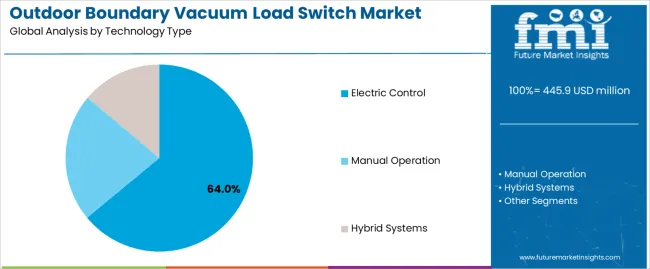
Market Position: Electric control switching systems command the leading position in the outdoor boundary vacuum load switch market with 64% market share through proven automation technologies, including remote operation capabilities, intelligent control systems, and operational reliability optimization that enable power operators to achieve optimal grid performance across diverse utility and industrial environments.
Value Drivers: The segment benefits from utility industry preference for automated switching systems that provide enhanced reliability, remote control capabilities, and operational efficiency without requiring manual intervention infrastructure. Advanced electric control features enable predictive maintenance, real-time monitoring, and integration with existing grid management systems, where performance reliability and operational automation represent critical infrastructure requirements.
Competitive Advantages: Electric control switching systems differentiate through proven automation reliability, advanced control characteristics, and integration with established grid management systems that enhance facility effectiveness while maintaining optimal electrical protection standards suitable for diverse power applications.
Key market characteristics:
Manual operation switching systems maintain a 28% market position in the outdoor boundary vacuum load switch market due to their cost advantages and proven reliability benefits. These systems appeal to facilities requiring straightforward switching solutions with established maintenance profiles for budget-conscious operations. Market presence is sustained by rural utility expansion, emphasizing cost-effective switching solutions and operational simplicity through traditional control designs.
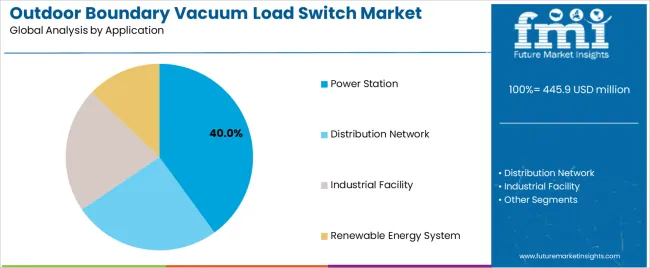
Market Context: Power station applications demonstrate strong growth in the outdoor boundary vacuum load switch market with 6.8% CAGR due to widespread adoption of advanced switching systems and increasing focus on generation reliability, operational cost efficiency, and power quality applications that maximize switching effectiveness while maintaining safety standards.
Appeal Factors: Power station operators prioritize switching reliability, operational consistency, and integration with existing generation infrastructure that enables coordinated switching operations across multiple generation units. The segment benefits from substantial power industry investment and modernization programs that emphasize the acquisition of premium switching equipment for grid stability and operational applications.
Growth Drivers: Power station expansion programs incorporate vacuum load switches as essential components for electrical protection, while renewable energy growth increases demand for switching capabilities that comply with grid codes and minimize operational complexity.
Market Challenges: Varying grid requirements and operational scale complexity may limit switching standardization across different power stations or generation scenarios.
Application dynamics include:
Distribution network applications capture 35% market share through specialized grid requirements in utility distribution systems, substations, and electrical infrastructure applications. These facilities demand reliable switches capable of supporting grid requirements while providing electrical protection access and operational reliability capabilities.
Industrial facility applications account for 18% market share, including manufacturing plants, commercial complexes, and industrial operations requiring performance switching capabilities for operational optimization and electrical safety.
Market Context: Utility Companies dominate the outdoor boundary vacuum load switch market with 6% CAGR, reflecting the primary demand source for vacuum load switch technology in electrical infrastructure applications and grid modernization.
Business Model Advantages: Utility Companies provide direct market demand for standardized switching systems, driving volume production and cost optimization while maintaining quality control and reliability requirements.
Operational Benefits: Utility Company applications include grid standardization, operational efficiency, and reliability assurance that drive consistent demand for switching systems while providing access to latest electrical technologies.
| Category | Factor | Impact | Why It Matters |
|---|---|---|---|
| Driver | Grid modernization & smart grid deployment (automation trends, digitalization) | ★★★★★ | Growing electrical infrastructure market requires advanced switching equipment with enhanced control capabilities and reliability properties proven effective across utility applications. |
| Driver | Renewable energy integration & distributed generation (solar, wind expansion) | ★★★★★ | Transforms switching requirements from "basic protection" to "intelligent control"; operators that offer advanced switching and grid integration features gain competitive advantage. |
| Driver | Infrastructure reliability demands & power quality requirements (grid stability, outage prevention) | ★★★★☆ | Critical infrastructure needs reliable, high-performance switching systems; demand for superior and dependable switching solutions expanding addressable market. |
| Restraint | High capital costs & budget constraints (especially for smaller utilities) | ★★★★☆ | Smaller utility operators defer switching upgrades; increases price sensitivity and slows premium switching adoption in cost-conscious markets. |
| Restraint | Traditional switching alternatives competition (air-insulated switches, SF6 alternatives) | ★★★☆☆ | Established switching technologies offer proven track records and lower costs, potentially limiting vacuum switch adoption in traditional applications. |
| Trend | Digitalization integration & condition monitoring (IoT connectivity, predictive maintenance) | ★★★★★ | Advanced monitoring capabilities, performance optimization, and predictive analytics transform operations; technology integration and condition monitoring become core value propositions. |
| Trend | Environmental compliance & eco-friendly solutions (SF6 alternatives, environmental regulations) | ★★★★☆ | Environmentally friendly switching solutions for regulatory compliance; specialized designs and environmental capabilities drive competition toward green solutions. |
The outdoor boundary vacuum load switch market demonstrates varied regional dynamics with Growth Leaders including China (7% growth rate) and India (6.5% growth rate) driving expansion through electrical infrastructure development initiatives and grid modernization programs. Steady Performers encompass Germany (6% growth rate), Brazil (5.5% growth rate), and developed regions, benefiting from established electrical infrastructure and advanced switching adoption. Mature Markets feature United States (4.9% growth rate), United Kingdom (4.4% growth rate), and Japan (3.9% growth rate), where grid advancement and reliability requirements support consistent growth patterns.
Regional synthesis reveals East Asian markets leading adoption through infrastructure expansion and power system development, while North American countries maintain steady expansion supported by grid modernization and reliability enhancement requirements. European markets show strong growth driven by renewable integration and environmental compliance trends.
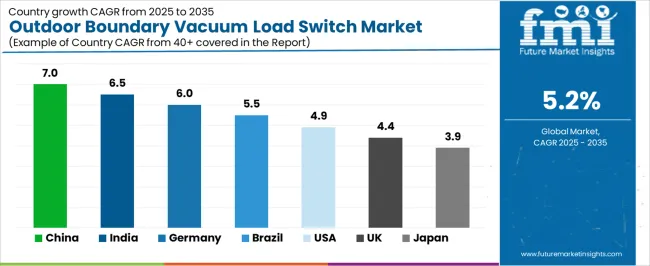
| Region/Country | 2025-2035 Growth | How to win | What to watch out |
|---|---|---|---|
| China | 7% | Focus on large-scale production solutions | Regulatory changes; local competition |
| India | 6.5% | Lead with cost-effective manufacturing | Import restrictions; technical barriers |
| Germany | 6% | Provide premium quality switches | Over-regulation; lengthy approvals |
| Brazil | 5.5% | Offer value-oriented solutions | Currency fluctuations; import duties |
| United States | 4.9% | Push technology integration | Compliance costs; scaling challenges |
| United Kingdom | 4.4% | Focus on premium applications | Economic impacts; infrastructure costs |
| Japan | 3.9% | Emphasize quality manufacturing | Traditional preferences; adoption rates |
China establishes fastest market growth through aggressive electrical infrastructure development programs and comprehensive grid modernization expansion, integrating advanced vacuum load switching systems as standard components in power stations and distribution installations. The country's 7% growth rate reflects government initiatives promoting electrical infrastructure and domestic switching capabilities that mandate the use of advanced switching systems in utility and industrial facilities. Growth concentrates in major industrial regions, including Beijing, Shanghai, and Guangzhou, where infrastructure development showcases integrated switching systems that appeal to utility operators seeking reliability optimization capabilities and operational applications.
Chinese manufacturers are developing cost-effective switching solutions that combine domestic production advantages with advanced vacuum features, including enhanced interruption control and improved reliability capabilities. Distribution channels through electrical distributors and utility suppliers expand market access, while government support for infrastructure development supports adoption across diverse utility and industrial segments.
Strategic Market Indicators:
In Mumbai, Delhi, and Bangalore, utility facilities and industrial operators are implementing advanced vacuum load switching systems as standard equipment for electrical protection and operational optimization applications, driven by increasing government infrastructure investment and grid modernization programs that emphasize the importance of reliable switching capabilities. The outdoor boundary vacuum load switch market holds a 6.5% growth rate, supported by government electrical initiatives and infrastructure development programs that promote advanced switching systems for utility and industrial facilities. Indian operators are adopting switching systems that provide consistent electrical protection and reliability features, particularly appealing in urban regions where power quality and operational excellence represent critical infrastructure requirements.
Market expansion benefits from growing electrical capabilities and international technology partnerships that enable domestic production of advanced switching systems for utility and industrial applications. Technology adoption follows patterns established in electrical equipment, where reliability and performance drive procurement decisions and operational deployment.
Market Intelligence Brief:
Germany's advanced electrical market demonstrates sophisticated vacuum load switch deployment with documented reliability effectiveness in utility applications and industrial facilities through integration with existing electrical systems and grid infrastructure. The country leverages engineering expertise in electrical systems and quality integration to maintain a 6% growth rate. Industrial centers, including Bavaria, Baden-Württemberg, and North Rhine-Westphalia, showcase premium installations where switching systems integrate with comprehensive electrical platforms and facility management systems to optimize power reliability and operational effectiveness.
German manufacturers prioritize system quality and EU compliance in switching development, creating demand for premium systems with advanced features, including grid integration and intelligent control systems. The outdoor boundary vacuum load switch market benefits from established electrical infrastructure and a willingness to invest in advanced switching technologies that provide long-term operational benefits and compliance with international electrical standards.
Market Intelligence Brief:
Brazil's market expansion benefits from diverse electrical demand, including infrastructure modernization in Rio de Janeiro and São Paulo, utility facility upgrades, and government electrical programs that increasingly incorporate advanced switching solutions for power applications. The country maintains a 5.5% growth rate, driven by rising industrial activity and increasing recognition of advanced switching benefits, including precise protection control and enhanced operational effectiveness.
Market dynamics focus on cost-effective switching solutions that balance electrical protection performance with affordability considerations important to Brazilian utility operators. Growing industrial development creates continued demand for modern switching systems in new electrical infrastructure and facility modernization projects.
Strategic Market Considerations:
United States establishes market leadership through comprehensive electrical programs and advanced power infrastructure development, integrating vacuum load switching systems across utility and industrial applications. The country's 4.9% growth rate reflects established electrical industry relationships and mature switching technology adoption that supports widespread use of advanced switching systems in utility and industrial facilities. Growth concentrates in major industrial centers, including California, Texas, and New York, where switching technology showcases mature deployment that appeals to utility operators seeking proven protection capabilities and operational efficiency applications.
American electrical providers leverage established distribution networks and comprehensive technical support capabilities, including installation programs and training support that create customer relationships and operational advantages. The outdoor boundary vacuum load switch market benefits from mature regulatory standards and electrical requirements that mandate switching system use while supporting technology advancement and operational optimization.
Market Intelligence Brief:
United Kingdom's electrical market demonstrates integrated vacuum load switch deployment with documented reliability effectiveness in utility applications and industrial facilities through integration with existing electrical systems and grid infrastructure. The country maintains a 4.4% growth rate, supported by electrical excellence programs and reliability requirements that promote advanced switching systems for electrical applications. Utility facilities across England, Scotland, and Wales showcase systematic installations where switching systems integrate with comprehensive electrical platforms to optimize power reliability and operational outcomes.
UK electrical providers prioritize system reliability and industry compatibility in switching procurement, creating demand for validated systems with proven protection features, including condition monitoring integration and intelligent control systems. The outdoor boundary vacuum load switch market benefits from established electrical infrastructure and stringent requirements that support the adoption of switching technology and operational effectiveness.
Market Intelligence Brief:
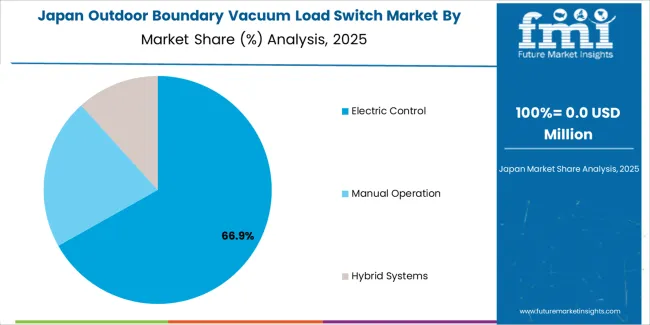
Japan's market growth benefits from precision electrical demand, including advanced utility facilities in Tokyo and Osaka, quality integration, and reliability enhancement programs that increasingly incorporate switching solutions for protection applications. The country maintains a 3.9% growth rate, driven by electrical technology advancement and increasing recognition of precision switching benefits, including accurate protection control and enhanced reliability outcomes.
Market dynamics focus on high-precision switching solutions that meet Japanese quality standards and reliability requirements important to electrical operators. Advanced electrical technology adoption creates continued demand for sophisticated switching systems in utility infrastructure and grid modernization projects.
Strategic Market Considerations:
The European outdoor boundary vacuum load switch market is projected to grow from USD 98.7 million in 2025 to USD 165.2 million by 2035, registering a CAGR of 5.3% over the forecast period. Germany is expected to maintain its leadership position with a 42.1% market share in 2025, supported by its advanced electrical infrastructure and major industrial centers.
United Kingdom follows with a 26.8% share in 2025, driven by comprehensive grid modernization programs and electrical excellence development initiatives. France holds a 16.4% share through specialized electrical applications and utility compliance requirements. Italy commands a 9.2% share, while Spain accounts for 5.5% in 2025. The rest of Europe region is anticipated to gain momentum, expanding its collective share from 2.3% to 2.8% by 2035, attributed to increasing electrical adoption in Nordic countries and emerging infrastructure facilities implementing grid modernization programs.
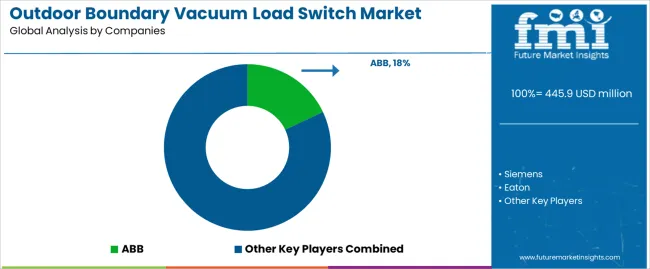
| Stakeholder | What they actually control | Typical strengths | Typical blind spots |
|---|---|---|---|
| Global brands | Distribution reach, broad product catalogs, brand recognition | Wide availability, proven reliability, multi-region support | Product refresh cycles; customer dependency on brand validation |
| Technology innovators | Vacuum technology R&D; advanced control systems; enhanced performance properties | Latest technologies first; attractive ROI on reliability effectiveness | Service density outside core regions; scaling complexity |
| Regional specialists | Local compliance, fast delivery, nearby customer support | "Close to customer" support; pragmatic pricing; local regulations | Technology gaps; talent retention in customer service |
| Full-service providers | Complete switching solutions, installation services, maintenance programs | Lowest operational risk; comprehensive support | Service costs if overpromised; technology obsolescence |
| Niche specialists | Specialized applications, custom switches, renewable energy solutions | Win premium applications; flexible configurations | Scalability limitations; narrow market focus |
| Item | Value |
|---|---|
| Quantitative Units | USD 445.9 million |
| Technology Type | Electric Control, Manual Operation, Hybrid Systems |
| Application | Power Station, Distribution Network, Industrial Facility, Renewable Energy System |
| End Use | Utility Companies, Industrial Operators, Renewable Energy Developers, Commercial Facilities, Infrastructure Contractors |
| Regions Covered | North America, Latin America, Western Europe, Eastern Europe, East Asia, South Asia Pacific, Middle East & Africa |
| Countries Covered | China, India, Germany, Brazil, United States, United Kingdom, Japan, Canada, France, Australia, and 25+ additional countries |
| Key Companies Profiled | ABB, siemens, Eaton, Schneider Electric, Alstom, Mitsubishi Electric, General Electric, Legrand, Toshiba |
| Additional Attributes | Dollar sales by technology type and application categories, regional adoption trends across East Asia, North America, and Europe, competitive landscape with electrical manufacturers and switching suppliers, utility operator preferences for switching effectiveness and reliability performance, integration with grid management platforms and SCADA systems, innovations in vacuum technology and switching enhancement, and development of advanced switching solutions with enhanced performance and operational optimization capabilities. |
The global outdoor boundary vacuum load switch market is estimated to be valued at USD 445.9 million in 2025.
The market size for the outdoor boundary vacuum load switch market is projected to reach USD 740.3 million by 2035.
The outdoor boundary vacuum load switch market is expected to grow at a 5.2% CAGR between 2025 and 2035.
The key product types in outdoor boundary vacuum load switch market are electric control, manual operation and hybrid systems.
In terms of application, power station segment to command 40.0% share in the outdoor boundary vacuum load switch market in 2025.






Full Research Suite comprises of:
Market outlook & trends analysis
Interviews & case studies
Strategic recommendations
Vendor profiles & capabilities analysis
5-year forecasts
8 regions and 60+ country-level data splits
Market segment data splits
12 months of continuous data updates
DELIVERED AS:
PDF EXCEL ONLINE
Outdoor LED Lighting Market Size and Share Forecast Outlook 2025 to 2035
Outdoor Payment Terminal Market Size and Share Forecast Outlook 2025 to 2035
Outdoor Commercial Grills Market Size and Share Forecast Outlook 2025 to 2035
Outdoor Kitchen Appliances Market Size and Share Forecast Outlook 2025 to 2035
Outdoor Furniture Market Size and Share Forecast Outlook 2025 to 2035
Outdoor Safety Locks Market Size and Share Forecast Outlook 2025 to 2035
Outdoor LED Display Market Size and Share Forecast Outlook 2025 to 2035
Outdoor Power Equipment Market Analysis Size and Share Forecast Outlook 2025 to 2035
Outdoor Living Structure Market Size and Share Forecast Outlook 2025 to 2035
Outdoor Toys Market Size and Share Forecast Outlook 2025 to 2035
Outdoor Apparel and Accessories Market Size and Share Forecast Outlook 2025 to 2035
Outdoor Public Safety Market Growth Size, Demand & Forecast 2025 to 2035
Outdoor Lighting Market Growth – Trends & Forecast 2025 to 2035
Outdoor Dining Table Market Trends - Growth & Forecast 2025 to 2035
Outdoor Bar Furniture Market
Outdoor Cat Houses & Furniture Market
Outdoor TV Market Analysis – Growth & Forecast 2022 to 2032
Outdoor Noise Barrier Market
Outdoor Residential Switchgear Market Size and Share Forecast Outlook 2025 to 2035
Rental Outdoor LED Display Market Size and Share Forecast Outlook 2025 to 2035

Thank you!
You will receive an email from our Business Development Manager. Please be sure to check your SPAM/JUNK folder too.
Chat With
MaRIA